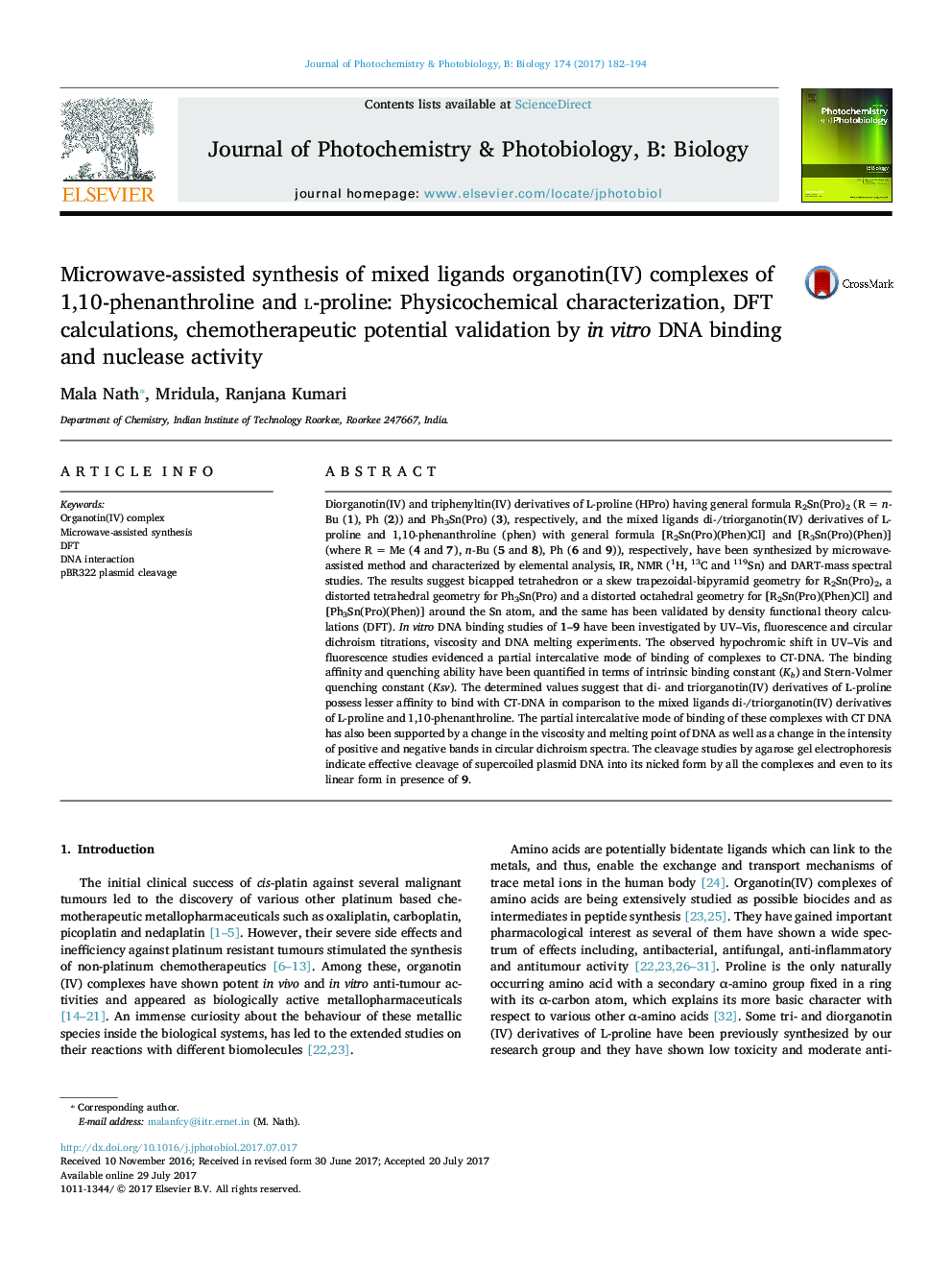| کد مقاله | کد نشریه | سال انتشار | مقاله انگلیسی | نسخه تمام متن |
|---|---|---|---|---|
| 4754335 | 1418059 | 2017 | 13 صفحه PDF | دانلود رایگان |

- Microwave assisted synthesis of organotin(IV) derivatives of L-proline
- Microwave assisted synthesis of mixed ligands organotin(IV) derivatives of L-proline and 1,10-phenanthroline
- In vitro DNA binding studies evidenced a partial intercalative mode of binding.
- Complexes displayed efficient cleavage of pBR322 DNA.
- Mixed ligands complexes exhibited higher DNA binding affinity and cleavage activity.
Diorganotin(IV) and triphenyltin(IV) derivatives of L-proline (HPro) having general formula R2Sn(Pro)2 (RÂ =Â n-Bu (1), Ph (2)) and Ph3Sn(Pro) (3), respectively, and the mixed ligands di-/triorganotin(IV) derivatives of L-proline and 1,10-phenanthroline (phen) with general formula [R2Sn(Pro)(Phen)Cl] and [R3Sn(Pro)(Phen)] (where RÂ =Â Me (4 and 7), n-Bu (5 and 8), Ph (6 and 9)), respectively, have been synthesized by microwave-assisted method and characterized by elemental analysis, IR, NMR (1H, 13C and 119Sn) and DART-mass spectral studies. The results suggest bicapped tetrahedron or a skew trapezoidal-bipyramid geometry for R2Sn(Pro)2, a distorted tetrahedral geometry for Ph3Sn(Pro) and a distorted octahedral geometry for [R2Sn(Pro)(Phen)Cl] and [Ph3Sn(Pro)(Phen)] around the Sn atom, and the same has been validated by density functional theory calculations (DFT). In vitro DNA binding studies of 1-9 have been investigated by UV-Vis, fluorescence and circular dichroism titrations, viscosity and DNA melting experiments. The observed hypochromic shift in UV-Vis and fluorescence studies evidenced a partial intercalative mode of binding of complexes to CT-DNA. The binding affinity and quenching ability have been quantified in terms of intrinsic binding constant (Kb) and Stern-Volmer quenching constant (Ksv). The determined values suggest that di- and triorganotin(IV) derivatives of L-proline possess lesser affinity to bind with CT-DNA in comparison to the mixed ligands di-/triorganotin(IV) derivatives of L-proline and 1,10-phenanthroline. The partial intercalative mode of binding of these complexes with CT DNA has also been supported by a change in the viscosity and melting point of DNA as well as a change in the intensity of positive and negative bands in circular dichroism spectra. The cleavage studies by agarose gel electrophoresis indicate effective cleavage of supercoiled plasmid DNA into its nicked form by all the complexes and even to its linear form in presence of 9.
Graphical AbstractComplexes 1-9 have been synthesized by microwave-assisted reactions and characterized. The results reveal bicapped tetrahedron or a skew trapezoidal-bipyramid geometry for R2Sn(Pro)2, a distorted tetrahedral geometry for Ph3Sn(Pro) and a distorted octahedral geometry for [R2Sn(Pro)(Phen)Cl], [R3Sn(Pro)(Phen)] around the Sn atom and the same has been validated by DFT. The complexes bind to CT-DNA via partial intercalation and displayed effective nuclease activity against plasmid pBR322 DNA.98
Journal: Journal of Photochemistry and Photobiology B: Biology - Volume 174, September 2017, Pages 182-194